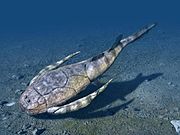| Dukecynus | |
|---|---|

| |
| Fossil illustration | |
| Scientific classification | |
| Kingdom: | |
| Phylum: | |
| Class: | |
| Order: | |
| Superfamily: | |
| Genus: | Dukecynus Goin, 1997
|
| species | |
| |
Dukecynus is an extinct genus of meat-eating metatherian belonging to the order Sparassodonta, which lived in South America during the Middle Miocene ( Laventan), between about 13.8 and 11.8 million years ago. [1] The name of the genus meaning "Duke dog", for Duke University and the Greek word cynos, dog, for the pretended similarity of this animal with dogs. A single species known so far, Dukecynus magnus. The species name "magnus" derives from Latin for big, to reflect their great size.
Description
Dukecynus is only known from its holotype, IGM 251149, a heavily damaged partial skull preserving parts of the lower and upper jaw as well as associated fragments of the skeleton. [1] This specimen was discovered at the Konzentrat-Lagerstätte La Venta in the Honda Group, Huila and Tolima in Colombia. A second fragmentary specimen from La Venta, cataloged as UCMP 39250, consisting of a fragmentary skull and parts of the humerus and femur from a juvenile individual, referred to "cf. Arctodictis" by Marshall (1978) could also belong to Dukecynus or a similar species. [2] [1] Although the affinities of this species have never been formally analysed, Dukecynus is generally considered to be a basal borhyaenoid, a paraphyletic group of sparassodonts that includes genera like Lycopsis and Prothylacynus that cannot be assigned to one of the major borhyaenoid families like Borhyaenidae or Thylacosmilidae. [3] Compared to other basal borhyaenoids, Dukecynus had a long, narrow snout and was relatively large, with some estimates suggesting this animal weighed up to 68 kilograms (150 lbs). [4] Dukecynus was probably the largest mammalian predator as well as the largest sparassodont at La Venta.
References
- ^ a b c Goin, F. J. 1997 New clues for understanding Neogene marsupial radiations. In A history of the neotropical fauna. Vertebrate paleobiology of the Miocene in Colombia (ed. R. F. Kay, R. H. Maden, R. L. Cifelli & J. Flynn), pp. 185–204. Washington DC: Smithsonian Institution Press.
- ^ Marshall, L. Evolution of the Borhyaenidae, extinct South American predaceous marsupials. Berkeley: University of California Press, 1978.
- ^ Forasiepi, Analía M. (2009). "Osteology of Arctodictis sinclairi (Mammalia, Metatheria, Sparassodonta) and phylogeny of Cenozoic metatherian carnivores from South America". Monografías del Museo Argentino de Ciencias Naturales. 6: 1–174.
- ^ Stephen Wroe, Christine Argot and Christopher Dickman. On the rarity of big fierce carnivores and primacy of isolation and area: tracking large mammalian carnivore diversity on two isolated continents. Proc. R. Soc. Lond. B (2004) 271, 1203–1211 1203, doi 10.1098/rspb.2004.2694
External links
- Marsupial `dogs', `bears', `sabre-tooths' and `weasels' of island South America: meet the borhyaenoids, by Darren Naish
- Бестиарий - Доисторические животные - Prehistoric Fauna (naturalistic reconstruction by Roman Uchytel)






